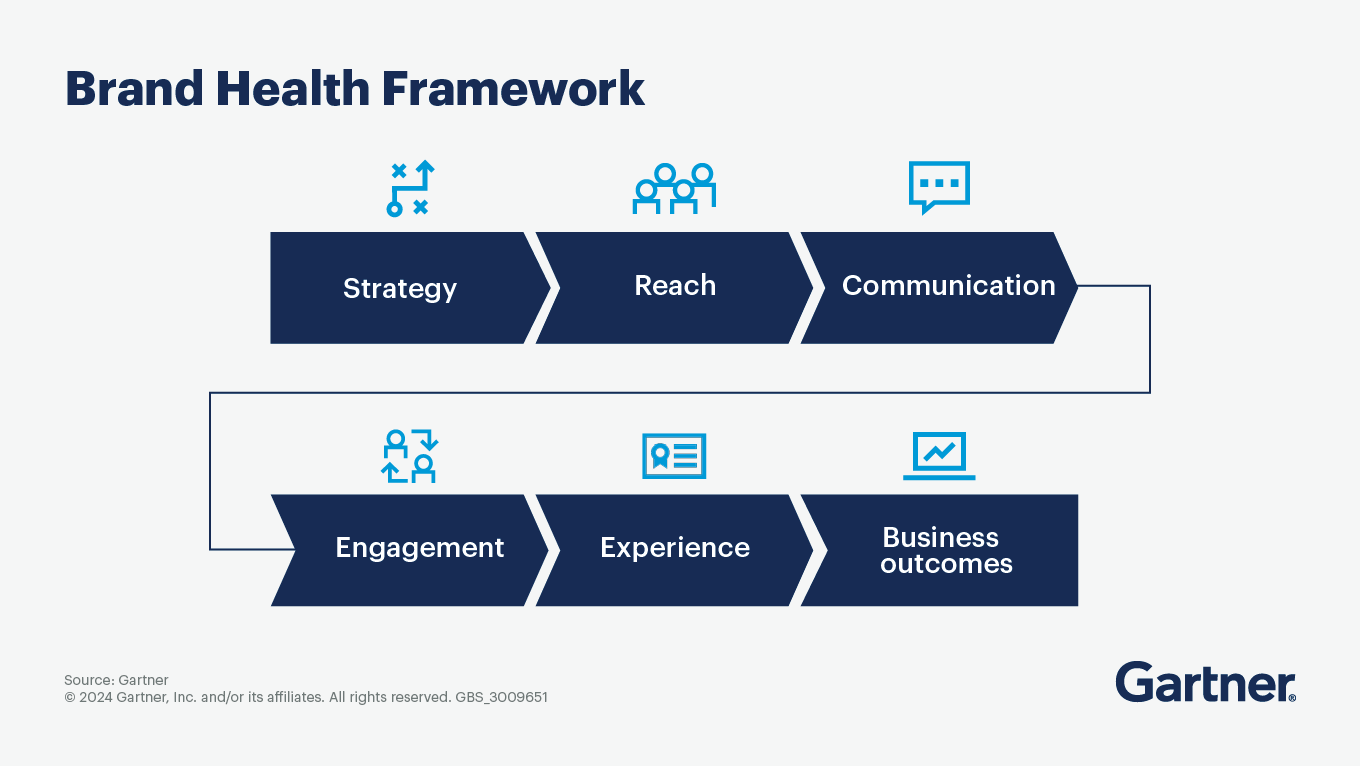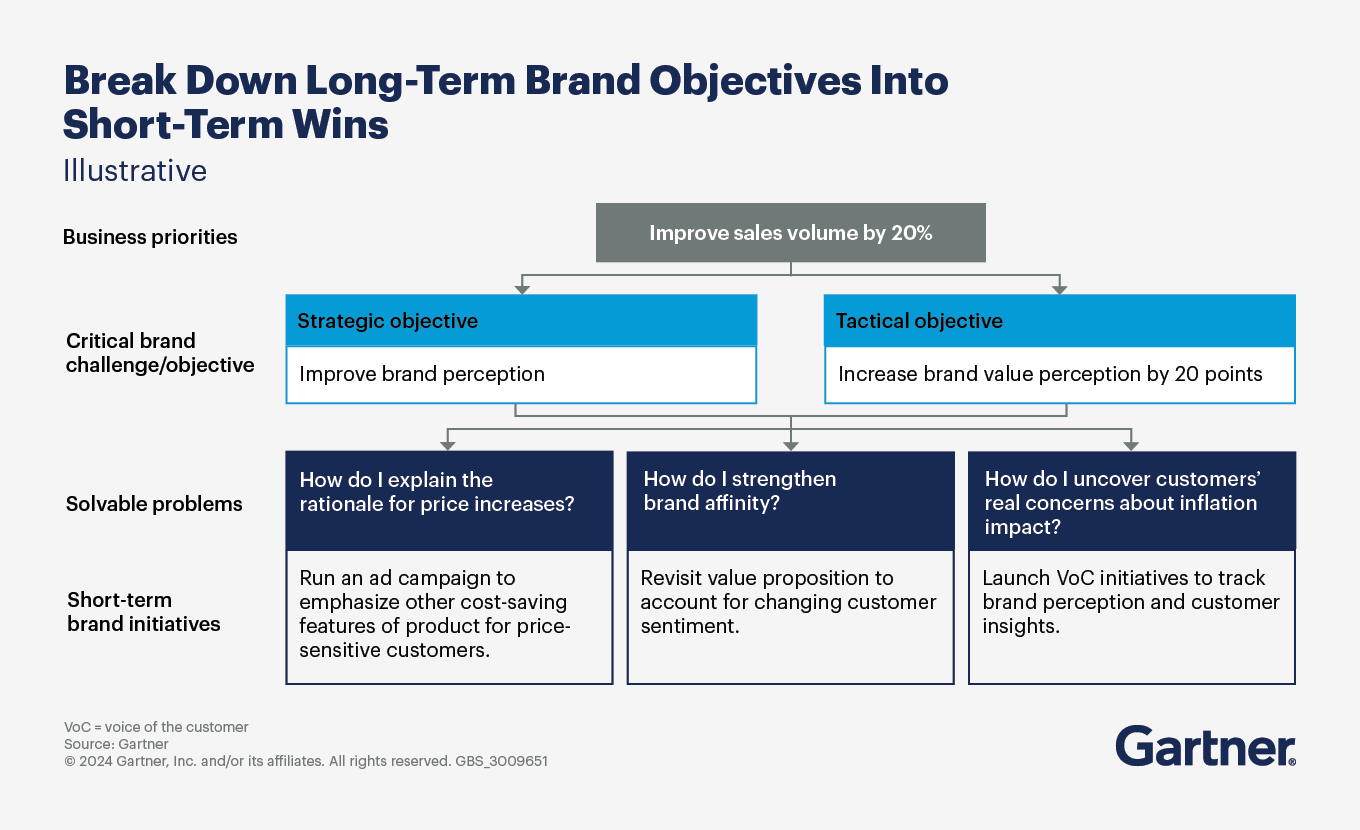Optimize brand strategy to foster brand health and buy-in.
- Gartner client? Log in for personalized search results.
Brand Strategy: Build a Brand That Drives Better Outcomes
Shape a brand strategy that boosts brand health and growth
Brand strategy remains a top CMO priority and a key competency for supporting organizational strategy. “A New Way to Measure Brand Health” helps you diagnose a brand health assessment through:
Identifying and answering key questions through the story your metrics are telling
Viewing, diagnosing and treating brand health issues quickly
Building a competitive advantage by driving brand engagement across your organization
Download your guide to shaping a brand strategy that helps engage customers and drive revenue.
Create a valued and differentiated brand strategy
Build a cohesive brand strategy that delivers on what’s important to the business and to your target audiences by taking these actions.
Secure Executive Buy-In
Improve Brand Governance
Build consensus with a brand strategy that balances short- and long-term outcomes
Market volatility, organizational change, inflationary pressures and budget constraints compel senior executives to deprioritize long-term growth in favor of short-term financial goals. These pressures can also affect brand strategy by forcing you to prioritize short-term goals like demand gen and sales conversion over multiyear brand investments.
Turn long-term brand goals into short-term wins
To protect your long-term brand strategy, factor in executives’ short-term goals and expectations at the planning stage.
Break down long-term issues and brand goals into near-term steps for creating a healthy brand strategy that can be executed right away. This helps reduce the level of abstraction and reframe brand aspiration into operational terms.
Include legitimate short-term business opportunities in the long-term roadmap. Effectively explain the rationale behind these decisions and the anticipated benefits they will bring, considering their impact on other departments, the entire business and your comprehensive marketing strategy.
Only pursue short-term investments that contribute to achieving a longer-term brand objective. Many short-term demands pull critical resources away from brand-building efforts while having little to moderate impact in the long run. Executive leaders should be able to see how brand-building efforts align with larger business goals and drive sustainable growth.
Keep conversations relevant to the short term by focusing on market disruptions and opportunities in the present that have long-term implications. For example, rising costs due to inflation can potentially have a lasting impact on customer attitudes and behaviors. To protect brand investments and meet business goals amid rising prices, break this issue down into addressable near-term actions that make sense to leaders outside of brand.
Balance immediate brand activation with sustainable brand building
Point-in-time brand activation campaigns are important for responding to market trends, generating immediate demand and getting real-time feedback on campaign spend. But always prioritizing these investments over longer-term brand-building efforts can result in a limited impact of all brand initiatives across the business.
Balance short-term brand activation and long-term brand building by taking two actions:
Maintain a healthy mix of short-term priorities and long-term payoffs to develop a synergistic brand strategy. By improving brand health holistically, you can enhance the impact of short-term brand activations, while deploying longer-term brand-building initiatives that are more potent in driving short-term impact than short-term initiatives are in driving long-term impact.
Prioritize metrics that align with the business and brand strategy. Choose metrics that highlight immediate results from short-term brand activation (including lead generation, brand awareness and inbound traffic) with brand equity measures that improve over a longer horizon (brand perception, purchase intent, brand loyalty).
Build and scale brand governance as part of your overall brand strategy
Over 80% of brand leaders agree that a strong brand requires all employees to strictly and consistently follow brand guidelines. But 58% of brand leaders acknowledge gaps in understanding the brand across their organizations.
Building brand governance maturation into your brand strategy can simplify the challenge of compliance as your business expands and acquires new brands.
Evaluate your brand governance structure’s current maturity across three areas — brand resources, organization and talent, and brand training — and then create an action plan to advance it to the next level as you engage your organization in brand development.
Nascent brand governance models have inconsistent, loosely documented brand resources. Approvals for brand work come from the head of marketing or CMO, and brand training is nonexistent.
To move a nascent model to the next level, do the following:
Formalize brand positioning as a core building block for all brand initiatives.
Compile key documents to help encapsulate your brand positioning statement.
Developing models have formally documented, consistent brand resources that teach core brand elements and illustrate the do’s and don’ts of brand representation. The CMO delegates approvals to senior marketers within corporate marketing, and the corporate marketing team receives training during onboarding on how to use and apply the brand resources.
To move a developing model to the next level, hire a senior brand leader who can collaborate cross-functionally and ensure continuous brand compliance by leading the creation and socialization of brand guidelines and assets.
Intermediate models orient employees on brand representation and how it aligns with higher-level organizational priorities. The brand leader heads corporate marketing’s branding efforts, and brand training is available on demand or when a major organizational change or a brand refresh occurs.
To move an intermediate model to the next level, do the following:
Align corporate and unit brand owners by collaborating with unit brand owners to create positioning statements that connect to corporate brand positioning.
Invest in digital asset management (DAM) — a self-serve content repository for all content and digital assets.
Advanced models include a range of actionable resources that give practical guidance and enable marketers to apply brands more effectively.
Corporate marketing approves all brand work, and unit-level teams may lightly tailor messaging to specific audiences.
Annual brand training dives into granular details, like modifying logos and differentiating color palettes.
To move an advanced model to the next level, do the following:
Assign brand representatives at a unit level to further distribute corporate marketing’s work and create flexible governance.
Equip the brand representatives to make informed brand decisions by developing tools such as decision trees to help identify brand implications for any projects.
Expert models customize brand resources based on corporate and unit-level priorities and include decision-making support.
Corporate marketing approves all work pertinent to the corporate brand, and unit-level brand representatives approve unit-level work.
Corporate marketing delivers specialized brand training to unit-level teams to help them develop their brand positioning.
Maintain the expert level by measuring and assessing brand health regularly.
Attend a Conference
Join Gartner experts and your peers to accelerate growth
Join CMOs and marketing executives to learn how to navigate emerging trends and challenges. From peer-led sessions to analyst one-on-ones, you'll leave ready to tackle your mission-critical priorities.
Gartner Marketing Symposium/Xpo™
Denver, CO

FAQ on brand strategy
What is a brand strategy, and why is it important?
A brand strategy is a comprehensive plan that outlines how a brand will be positioned in the market, differentiate itself from competitors and resonate with its target audience. It encompasses the brand’s mission, values, messaging and visual identity. A strong brand strategy is crucial because it guides all marketing efforts, builds customer loyalty and drives business growth by creating a clear and consistent brand experience that aligns with business objectives.
What common brand strategy mistakes should you avoid?
Common mistakes include lacking a clear understanding of the target audience, inconsistent messaging and neglecting competitive analysis. Avoid overcomplicating the strategy; simplicity and clarity are key. Failing to engage stakeholders or ignoring customer feedback can also hinder success. Additionally, not adapting to market changes or technological advancements can render a brand strategy ineffective. Regularly review and update the strategy to maintain relevance and effectiveness.
How often should a brand strategy be reviewed and updated?
A brand strategy should be reviewed at least annually to ensure it remains aligned with evolving market trends, consumer behavior and business goals. However, significant changes in the industry, competitive landscape or internal business objectives may necessitate more frequent reviews. Regular assessments allow for timely adjustments, ensuring the brand remains relevant, competitive and effectively positioned to meet its strategic objectives.
Drive stronger performance on your mission-critical priorities.

